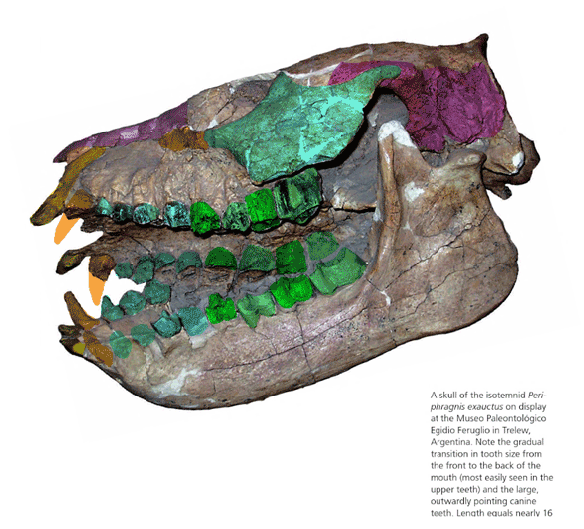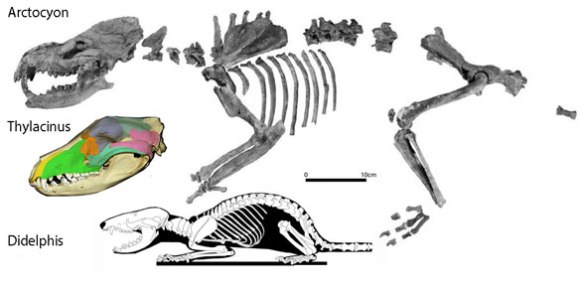Periphrangis harmeri (Roth 1899; Fig. 1; Oligocene, 48-28 mya) has long been considered a notoungulate. Earlier the LRT nested two former notoungulates as wombats. Periphranigis also shares several wombat traits, including a jugal that contacts the jaw glenoid, procumbent incisors and a septomaxilla.

Figure 1. Periphrangis was considered a notoungulate, but it is clearly a wombat with four molars and a jugal that contacts the jaw glenoid, among several other identifying traits.
When we first looked at Haramiyavia
(Jenkins et al. 1997, Luo et al. 2005) here, this small Late Triassic mammal was considered a basal multituberculate. Now that several wombats have been added to the LRT Haramiyava could be another wombat. Wombats share procumbent incisors and a convex ventral mandible. Hard to tell with present data. In either case, both wombats and multituberculates are rather derived taxa for the Late Triassic.

Figure 2. Haramiyavia reconstructed and restored. Missing parts are ghosted. Three slightly different originals are used for the base here.
Arctocyon
(Fig. 3; Blainville 1841, Gould and Rose 2014; YPM VP 021233; 60 mya) was long and widely considered (see Wikipedia page) a primitive plantigrade ungulate condylarth procreodi placental. In the LRT Arctocyon nests with basal carnivorous/omnivorous marsupials. Essentially it is a giant opossum, like Didelphis, but with a few derived traits, more like Thylacinus, a taxon that reduces the epipubes and molar count, hence the earlier traditional confusion. Just look at these taxa side-by-side. It’s obvious, but it’s also in the matrix scores.

Figure 3. Arctocyon mumak is no longer an ungulate placental, but a carnivorous marsupial, close to Thylacinus.
Small brains and long jugals extending to the jaw glenoid
also give them away as metatherians. Not sure why even recent authors (Gould and Rose 2014) are not seeing this. They must be counting molars.
References
Blainville HM 1841. Osteographie et description iconographique des Mammiferes récentes et fossiles (Carnivores) 1, 2 Paris.
Gould FDH and Rose KD 2014. Gnathic and postcranial skeleton of the largest known arctocyonid ‘condylarth’ Arctocyon mumak (Mammalia, Procreodi) and ecomorphological diversity in Procreodi. Journal of Vertebrate Paleontology 34(5):1180-1202.
Jenkins FA, Jr, Gatesy SM, Shubin NH and Amaral WW 1997. Haramiyids and Triassic mammalian evolution. Nature 385(6618):715–718.
Luo Z-X, Gatesy SM, Jenkins FA, Jr, Amaralc WW and Shubin NH 2015. Mandibular and dental characteristics of Late Triassic mammaliaform Haramiyavia and their ramifications for basal mammal evolution. PNAS 112 (51) E7101–E7109.
Roth S 1899. Aviso preliminar sobre mamíferos mesozóicos encontrados en Patagonia [Preliminary notice on Mesozoic mammals found in Patagonia]. Revista del Museo de La Plata 9:381-388
